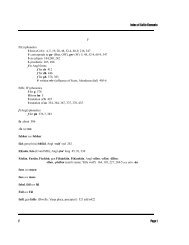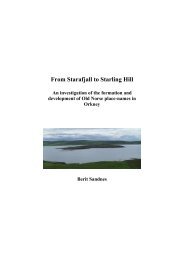May Williamson: The Non-Celtic Place-Names of the Scottish Border ...
May Williamson: The Non-Celtic Place-Names of the Scottish Border ...
May Williamson: The Non-Celtic Place-Names of the Scottish Border ...
You also want an ePaper? Increase the reach of your titles
YUMPU automatically turns print PDFs into web optimized ePapers that Google loves.
v<br />
20. Meta<strong>the</strong>sis is a very common feature <strong>of</strong> MSc, especially with r. Brunt- for burntoccurs<br />
frequently in place-names. A few names display elaborate meta<strong>the</strong>sis in<br />
early forms, eg Tushielaw, Annelshope.<br />
21. Epen<strong>the</strong>sis occurs in several cases. In Rumbleton, ml > mbl; in Stantling nl may<br />
become ntl; in Standhill nl may become ndl. 16th century spellings <strong>of</strong> Amisfield as<br />
Hempsfeild, etc, show ms > mps (No XIX).<br />
22. Assimilation and dissimilation are frequent. Various examples are noted in <strong>the</strong><br />
text.<br />
23. Few OE grammatical case-endings are preserved. Four examples <strong>of</strong> <strong>the</strong> dative<br />
plural in -um occur in Denholm, Whitsome, Hume and Ellem.<br />
/xii/ Oblique endings in -an were lost in ONb and do not <strong>the</strong>refore appear in NME. Spellings<br />
for Brunanburh and Degsastan which exhibit weak endings in -an may be due to scribes<br />
unfamiliar with nor<strong>the</strong>rn usage.<br />
<strong>The</strong> MSc present participle in -and is seen only in a spelling for Trottingshaw, as<br />
Trottandschaw, 1492.<br />
MSc past participles in -it appear in Kippitlaw, 1557-8, and Senegideside, late 13 th century,<br />
which may represent sengit-side.<br />
PALATALISATION<br />
* * * * * * *<br />
Although no evidence <strong>of</strong> vowel diphthongisation after palatal consonants is afforded by <strong>the</strong><br />
material collected for <strong>the</strong> <strong>Border</strong> area, it is plain from mediaeval spellings and modern<br />
pronunciation that in most cases initial back consonants were palatalised before front vowels.<br />
Initial ċ[tS] is found in <strong>the</strong> modern form chester, from OE ċæster. <strong>The</strong> e is not a development<br />
<strong>of</strong> OE ea, but a fronted form <strong>of</strong> ONb æ, ME a. A similar case, but without 1ME fronting <strong>of</strong><br />
<strong>the</strong> vowel, is seen in /xiii/ Chatto, from an OE personal name *Cætt.<br />
OE ċiriċe > ME chirche was early replaced by ME kirke (ModSc kirk) from ON kirkja.<br />
Spellings in chirche in <strong>the</strong> 12 th and 13 th centuries might already represent [kIrk@] since chwas<br />
frequently written for [k] in <strong>the</strong> Anglo-Norman script (IPN i, 102). Norman influence is<br />
practically non-existent in place-name material in this area, however, and it is doubtful<br />
whe<strong>the</strong>r chi- ever represented anything but [tSI] in our spellings. Forms for Channelkirk show<br />
that in one case at any rate ch- was a palatal sound, since in <strong>the</strong> 12 th century form<br />
Childenchirch it is certain that <strong>the</strong> first ch- represented [tS], and it is <strong>the</strong>refore unlikely that <strong>the</strong><br />
o<strong>the</strong>r two had a different pronunciation.<br />
Initial precedes OE æ in æt and ærd, <strong>the</strong> ModSc forms <strong>of</strong> which are yett and yard: cf <strong>The</strong><br />
Yett, Yetholm, and Ashyards. Present-day names in -gate are ei<strong>the</strong>r very recent in origin or<br />
represent ON gata, “a road”.




